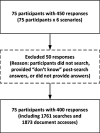Do people experience cognitive biases while searching for information?
- PMID: 17600097
- PMCID: PMC1975788
- DOI: 10.1197/jamia.M2411
Do people experience cognitive biases while searching for information?
Abstract
Objective: To test whether individuals experience cognitive biases whilst searching using information retrieval systems. Biases investigated are anchoring, order, exposure and reinforcement.
Design: A retrospective analysis and a prospective experiment were conducted to investigate whether cognitive biases affect the way that documentary evidence is interpreted while searching online. The retrospective analysis was conducted on the search and decision behaviors of 75 clinicians (44 doctors, 31 nurses), answering questions for 8 clinical scenarios within 80 minutes in a controlled setting. The prospective study was conducted on 227 undergraduate students, who used the same search engine to answer two of six randomly assigned consumer health questions.
Measurements: Frequencies of correct answers pre- and post- search, and confidence in answers were collected. The impact of reading a document on the final decision was measured by the population likelihood ratio (LR) of the frequency of reading the document and the frequency of obtaining a correct answer. Documents with a LR > 1 were most likely to be associated with a correct answer, and those with a LR < 1 were most likely to be associated with an incorrect answer to a question. Agreement between a subject and the evidence they read was estimated by a concurrence rate, which measured the frequency that subjects' answers agreed with the likelihood ratios of a group of documents, normalized for document order, time exposure or reinforcement through repeated access. Serial position curves were plotted for the relationship between subjects' pre-search confidence, document order, the number of times and length of time a document was accessed, and concurrence with post-search answers. Chi-square analyses tested for the presence of biases, and the Kolmogorov-Smirnov test checked for equality of distribution of evidence in the comparison populations.
Results: A person's prior belief (anchoring) has a significant impact on their post-search answer (retrospective: P < 0.001; prospective: P < 0.001). Documents accessed at different positions in a search session (order effect [retrospective: P = 0.76; prospective: P = 0.026]), and documents processed for different lengths of time (exposure effect [retrospective: P = 0.27; prospective: P = 0.0081]) also influenced decision post-search more than expected in the prospective experiment but not in the retrospective analysis. Reinforcement through repeated exposure to a document did not yield statistical differences in decision outcome post-search (retrospective: P = 0.31; prospective: P = 0.81).
Conclusion: People may experience anchoring, exposure and order biases while searching for information, and these biases may influence the quality of decision making during and after the use of information retrieval systems.
Figures












Similar articles
-
Can cognitive biases during consumer health information searches be reduced to improve decision making?J Am Med Inform Assoc. 2009 Jan-Feb;16(1):54-65. doi: 10.1197/jamia.M2557. Epub 2008 Oct 24. J Am Med Inform Assoc. 2009. PMID: 18952948 Free PMC article.
-
How do clinicians search for and access biomedical literature to answer clinical questions?Stud Health Technol Inform. 2007;129(Pt 1):152-6. Stud Health Technol Inform. 2007. PMID: 17911697
-
Impact of web searching and social feedback on consumer decision making: a prospective online experiment.J Med Internet Res. 2008 Jan 22;10(1):e2. doi: 10.2196/jmir.963. J Med Internet Res. 2008. PMID: 18244893 Free PMC article.
-
Internet-based information-seeking behaviour amongst doctors and nurses: a short review of the literature.Health Info Libr J. 2010 Mar;27(1):2-10. doi: 10.1111/j.1471-1842.2010.00883.x. Health Info Libr J. 2010. PMID: 20402799 Review.
-
Efficiently finding and using evidence to guide clinical practice and improve care.JAAPA. 2017 Nov;30(11):31-38. doi: 10.1097/01.JAA.0000525915.05473.01. JAAPA. 2017. PMID: 29064936 Review.
Cited by
-
[Effect of the use of heuristics on diagnostic error in Primary Care: Scoping review].Aten Primaria. 2020 Mar;52(3):159-175. doi: 10.1016/j.aprim.2018.11.003. Epub 2019 Jan 31. Aten Primaria. 2020. PMID: 30711287 Free PMC article. Spanish.
-
Information seeking and social support in online health communities: impact on patients' perceived empathy.J Am Med Inform Assoc. 2011 May 1;18(3):298-304. doi: 10.1136/amiajnl-2010-000058. J Am Med Inform Assoc. 2011. PMID: 21486888 Free PMC article.
-
Can "Googling" correct misbelief? Cognitive and affective consequences of online search.PLoS One. 2021 Sep 22;16(9):e0256575. doi: 10.1371/journal.pone.0256575. eCollection 2021. PLoS One. 2021. PMID: 34550993 Free PMC article.
-
How online crowds influence the way individual consumers answer health questions: an online prospective study.Appl Clin Inform. 2011 Jun 1;2(2):177-89. doi: 10.4338/ACI-2011-01-RA-0006. Print 2011. Appl Clin Inform. 2011. PMID: 23616869 Free PMC article.
-
Manipulating Google's Knowledge Graph Box to Counter Biased Information Processing During an Online Search on Vaccination: Application of a Technological Debiasing Strategy.J Med Internet Res. 2016 Jun 2;18(6):e137. doi: 10.2196/jmir.5430. J Med Internet Res. 2016. PMID: 27255736 Free PMC article.
References
-
- Hersh WR. Evidence-based medicine and the internet ACP J Club 1996;125:A14-A16. - PubMed
-
- Morrison JB, Pirolli P, Card SK. A taxonomic analysis of what world wide web activities significantly impact people’s decisions and actions Conference on Human Factors in Computing System. New York: ACM Press; 2001.
-
- Hersh WR. Ubiquitous but unfinished: On-line information retrieval systems Med Decis Making 2005;25:147-148. - PubMed
Publication types
MeSH terms
LinkOut - more resources
Full Text Sources

